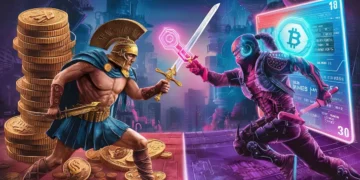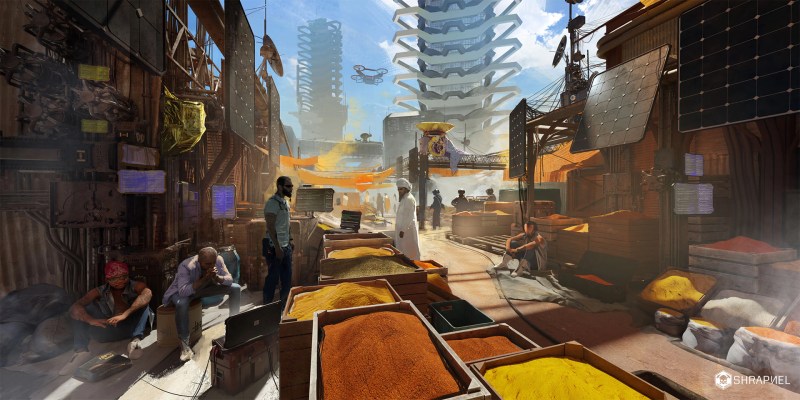Blockchain isn’t one giant monolith—it’s built in layers, each doing a specific job. You’ve probably heard terms like Layer 1 or Layer 2 thrown around, but what do they actually mean? From the raw hardware powering nodes to the smart contracts running your favorite dApps, blockchain layers explain how the whole system works.
This guide breaks it all down—clearly, simply, and with real-world examples—so you can finally see how everything stacks together.
Why Understanding Blockchain Layers Matters
Crypto talk is full of buzzwords. Layers of blockchain—Layer 1, Layer 2, Layer 0—get tossed around like everyone knows what they mean. But most don’t.
Each layer plays a role: security, scalability, speed. When you know which layer does what, it all starts to make sense. You’ll get why Bitcoin is slow but solid. Or why Ethereum needs rollups to handle congestion.
Layers aren’t just technical fluff. They’re how blockchains grow, improve, and connect. Think of it like a tech stack—each part solving a specific problem. Once you understand the stack, you see the bigger picture. And that’s when blockchain really clicks.
What Are Blockchain Layers?
Blockchain layers are the structural components that divide a blockchain system into specialized parts. Each layer has its own role: some manage how data is stored and shared, others make sure everyone agrees on the current state of the network, and some handle user-facing applications.
This layered setup helps developers improve parts of the system without changing everything at once. It also makes blockchains more scalable, modular, and easier to upgrade.
Why Does Blockchain Infrastructure Need Layers?
Early blockchains like Bitcoin aimed to do everything in one place. As a result, you got strong security, but poor scalability. That’s where layering comes in—as a structural fix.
A layered setup allows each component of a blockchain protocol to focus on its core task. One layer handles data flow, another secures the network, and yet another scales performance. For example, Ethereum remains secure at its base, while Layer 2 rollups process multiple transactions off-chain to ease congestion and reduce fees.
This separation also allows focused innovation. Developers can roll out consensus protocol improvements on Layer 1 without disrupting apps or token transfers built on Layer 2 or Layer 3. It’s like tuning an engine while the rest of the car keeps running.
Layering isn’t just about performance—it’s what makes blockchain adaptable. It gives the technology room to evolve without losing what made it valuable to begin with.
The Layered Structure of Blockchain Technology
Imagine a computer: hardware at the bottom, apps at the top. A blockchain is built similarly—from the machines running it to the smart contracts you interact with.
Each layer builds on the one below. Together, they form the complete blockchain system—functional, secure, and scalable from top to bottom.
Hardware Layer
This is the physical base. It includes all the nodes, servers, and internet infrastructure powering the chain. Bitcoin mining rigs, validator nodes, storage clusters—they all live here. Without this hardware backbone, nothing moves.
It’s where blocks are stored, code is run, and networks stay alive.
Data Layer
This is where the transaction data lives. It’s the actual blockchain—linked blocks forming a public ledger. Each block records what happened: wallet addresses, amounts, timestamps, and references to the block before it.
Thanks to cryptographic tools like Merkle trees, this layer makes sure no data can be altered. It keeps the chain honest, permanent, and transparent.
Network Layer
This is the communication layer. Nodes talk to each other here, sharing data and blocks in a decentralized way. When a new transaction is created, it spreads through the network like a signal in a nervous system.
This layer ensures that all participants stay in sync. It’s vital for coordination and network security.
Consensus Layer
This layer makes sure everyone agrees. Different blockchains use different consensus algorithms—like Proof-of-Work or Proof-of-Stake—but they all serve the same purpose: reaching consensus without a central authority.
It’s where transaction validation happens and double-spending is prevented. Whether it’s miners burning energy or validators locking coins, they all contribute to keeping the network fair, secure, and decentralized.
Application Layer
At the top, we find what most users recognize: wallets, DEXs, games, DeFi tools. All live in the application layer. It’s where smart contracts execute logic and turn the blockchain into something useful.
From NFT marketplaces to lending protocols, this layer gives real-world value to the stack below it. And it’s where blockchain scalability becomes critical—apps need the lower layers to perform well or risk losing users.
Blockchain Layers 0, 1, 2 and 3
So far, we’ve covered the internal structure of a blockchain. But when people say “Layer 0,” “Layer 1,” and so on—they’re talking about how blockchain networks stack on top of each other. Here’s what each layer does, why it matters, and where real-world projects fit in.

Layer 0: The Foundation Layer
Layer 0 is the base infrastructure. It connects different blockchains and allows them to share data and security. Think of it as the system of highways between cities (chains). Projects like LayerZero, Polkadot, Cosmos, and Avalanche all fall into this category. They enable cross-chain swaps, shared validation, and faster launches of new chains.
Cosmos uses IBC for blockchain communication. Polkadot connects parachains through its Relay Chain. Avalanche supports subnetworks for specialized use. These tools don’t run dApps directly—instead, they let others build and interconnect.
Without Layer 0, we’d be stuck with siloed chains. With it, we get speed, interoperability, and a flexible base for the entire blockchain ecosystem.
We break it down further here: What Is Layer 0?
Layer 1: The Blockchain Base Layer
Layer 1 is the main chain—the network that stores data, validates transactions, and runs smart contracts. Bitcoin, Ethereum, Solana, Cardano—each is its own Layer 1 protocol.
The Bitcoin network is a textbook L1. It’s slow but incredibly secure. Ethereum brings smart contracts into the mix, powering entire ecosystems.
Most L1s run into bottlenecks, though. High demand means high transaction fees. The infamous CryptoKitties congestion showed how L1s struggle with scale.
To validate transactions securely, L1s use consensus mechanisms like PoW or PoS. Changes are hard and slow to implement in these chains, which limits their flexibility.
Want more details? Check out our full guide: What Is Layer 1?
Layer 2: Scaling and Speed Enhancement Solutions
Layer 2 solutions plug into Layer 1 to speed things up and cut costs. They process activity off-chain, then post the final results on-chain. Rollups, sidechains, and channels all follow this model.
The idea first appeared in 2015 with the Lightning Network whitepaper by Joseph Poon and Thaddeus Dryja. It was the first major scaling solution for the Bitcoin blockchain, built to support faster, cheaper payments without touching the base chain too often.
On Ethereum, rollups like Optimism and zkSync bundle transactions and reduce gas costs. Layer 1 fees can spike to $20-$40 per transaction during busy periods. L2s cut that down to just $0.04–$0.09.
On the Bitcoin network, the Lightning Network works as an adjacent network and handles off-chain payments with near-zero fees—letting you finish your bitcoin transactions almost instantly.
So, L2s don’t replace the base chain—they inherit its security and lean on it for final settlement. That’s why this combo works: L1 brings trust, L2 brings speed.
For a deeper dive, read: What Is Layer 2?
Layer 3: The Application Layer
This is where users meet blockchain. Wallets, DeFi apps, NFT marketplaces, games—all of them live here. Many popular apps currently run on the Ethereum blockchain or its L2s. Solana is another widely used platform for building user-facing applications.
The concept of Layer 3 (L3) was introduced by Vitalik Buterin in 2015, focusing on application-specific functionalities built on top of Layer 2 solutions. L3 aims to provide customizable and scalable solutions for decentralized applications (dApps), enhancing user experience and interoperability .
Layer 3 apps don’t need their own consensus. They just need a solid foundation beneath them. Whether it’s Uniswap, OpenSea, or MetaMask, they use smart contracts and UIs to abstract away the technical mess.
Some Layer 3s even span multiple chains—like bridges, oracles, or wallets that connect nested blockchains. This is where blockchain developers innovate, build, and create real-world value on top of the stack.
Differences Between Layers 0, 1, 2, and 3
| Layer | Brief Description | Purpose | Key Characteristics | Examples |
| Layer 0 | Foundation for blockchain networks | Enable interoperability and support for multiple blockchains | Provides infrastructure and protocols for cross-chain communication | Polkadot, Cosmos, Avalanche |
| Layer 1 | Base blockchain protocols | Maintain core network consensus and security | Processes and records transactions on a decentralized ledger | Bitcoin, Ethereum, Solana |
| Layer 2 | Scaling solutions on top of Layer 1 | Enhance transaction throughput and reduce fees | Offloads transactions from Layer 1, then settles them back | Lightning Network, Optimism, Arbitrum |
| Layer 3 | Application layer | Deliver user-facing decentralized applications | Interfaces like wallets, DeFi apps, and games built on underlying layers | Uniswap, OpenSea, MetaMask |
None of these layers is “better” universally. Instead, they complement each other to form a complete blockchain.
How These Layers Work Together
Blockchain layers work like gears in a machine—each handling a specific task and passing output to the next layer. Layer 0 connects networks, Layer 1 secures the main blockchain, Layer 2 boosts performance, and Layer 3 brings in the user. Take a DeFi app: the UI runs on Layer 3, the smart contracts sit on the Ethereum network (Layer 1), while large trades might route through a rollup (Layer 2). If that app also lets users trade across chains, it likely uses a Layer 0 like Cosmos. One action, four layers—working in sync.
And, they’re not siloed. They stack. A better cryptographic proof system at L2 can speed up apps at L3. A Layer 0 upgrade could connect multiple blockchains, giving developers more tools and users more access. Each layer sharpens the next. Together, they form a system more powerful than any single-layer chain could ever be.
This synergy helps solve the blockchain trilemma—the challenge of achieving security, decentralization, and scalability all at once. Layer 1 protects decentralization and security. Layer 2 scales. Layer 3 makes it usable. No single layer can nail all three, but together, they cover each angle.

Final Words
The layered model is how blockchains grow up. Each level handles its job without overloading the rest. That means more scale, better UX, and fewer trade-offs. Want to upgrade? Add a new rollup, not a whole new chain.
This approach powers real adoption and lets us build new tools without breaking what already works.
The future isn’t one chain. It’s many. It’s nested blockchains, interlinked protocols, and flexible stacks. And the more refined each layer becomes, the closer we get to blockchains that are fast, secure, and ready for anything.
FAQ
Is Layer 1 better than Layer 2 or Layer 3?
Not better—just different in role and functionality. Layer 1 provides the base security and decentralization. Layer 2 is a scaling solution, boosting speed and lowering fees. Layer 3 sits on top, powering apps like wallets, DEXs, and games. Rather than comparing them, it’s better to see them as parts of a full-stack blockchain architecture. They work in tandem: a Layer 3 app might process trades through a Layer 2 rollup while relying on Layer 1 to confirm everything securely.
Can a blockchain exist without all the layers?
Yes. Many blockchains, like the Bitcoin blockchain, operate just fine without Layer 0 or 2. Every chain has internal layers (hardware, consensus, etc.)—those are part of any blockchain technology. But external layers like L2 or L3 are optional. Some blockchains stay lean; others scale by layering. It depends on goals and design.
What’s the difference between Layer 2 and sidechains?
Layer 2 sits “on top” of Layer 1 and uses its security. Sidechains run next to the main chain and have their own validators. That’s the difference.
Layer 2s rely on Layer 1 for security—they post cryptographic proofs back to the main chain and inherit its consensus. Rollups and state channels (L2) post cryptographic proofs back to the main chain.
Sidechains, however, operate independently. They process sidechain transactions using their own consensus mechanisms and validators, separate from the main chain. This makes sidechains more flexible, but also less secure. If a sidechain fails, users may lose funds. A Layer 2 chain, in contrast, lets users fall back on Layer 1 for dispute resolution and finality.
How do I know if a project is a Layer 1, Layer 2, or Layer 3?
It depends on what the project is building. If it runs its own network, it’s likely Layer 1. If it speeds up another chain, it’s Layer 2. If it offers apps like DeFi or NFTs, it’s Layer 3.
For example, Uniswap is Layer 3 because it runs on the Ethereum blockchain, while Ethereum itself is Layer 1. Optimism is Layer 2—it’s a rollup that improves Ethereum’s performance.
When unsure, check if the project depends on another chain—that usually means L2 or L3. Over time, you will get used to spotting these different layers.
Is there a Layer 4 blockchain?
No, not in mainstream crypto. Some call the user interface “Layer 4,” but that’s UI, not infrastructure. It’s more frontend than blockchain. After Layer 3, you’re usually outside the chain—on web apps, wallets, or browsers. So no real Layer 4 blockchain, just extended models.
Is Every Blockchain Layered?
Technically yes. Every chain has core layers (hardware, data, network, etc.). But not all chains have L2s or L3s. For example, a basic Bitcoin blockchain node runs all internal layers, but no external ones. Some chains are small and self-contained, while others—like Ethereum—are built out with multiple layers to support more apps and users. So while every blockchain has a layered design, the depth and complexity vary widely. Layering is a tool, not a rule.
Are Layers Interchangeable or Fixed?
They’re fixed in function, but flexible in design. You can’t swap a Layer 2 for a Layer 1—they serve different purposes. Each sits in a specific position in the system. But you can replace one Layer 2 with another, or upgrade a Layer 3 app. The stack is like a blueprint: L0 supports L1, L1 secures L2, L2 powers L3. That order keeps the system reliable. So while you can change the tools inside a layer, the structure itself stays the same.
Disclaimer: Please note that the contents of this article are not financial or investing advice. The information provided in this article is the author’s opinion only and should not be considered as offering trading or investing recommendations. We do not make any warranties about the completeness, reliability and accuracy of this information. The cryptocurrency market suffers from high volatility and occasional arbitrary movements. Any investor, trader, or regular crypto users should research multiple viewpoints and be familiar with all local regulations before committing to an investment.
Blockchain isn’t one giant monolith—it’s built in layers, each doing a specific job. You’ve probably heard terms like Layer 1 or Layer 2 thrown around, but what do they actually mean? From the raw hardware powering nodes to the smart contracts running your favorite dApps, blockchain layers explain how the whole system works.
This guide breaks it all down—clearly, simply, and with real-world examples—so you can finally see how everything stacks together.
Why Understanding Blockchain Layers Matters
Crypto talk is full of buzzwords. Layers of blockchain—Layer 1, Layer 2, Layer 0—get tossed around like everyone knows what they mean. But most don’t.
Each layer plays a role: security, scalability, speed. When you know which layer does what, it all starts to make sense. You’ll get why Bitcoin is slow but solid. Or why Ethereum needs rollups to handle congestion.
Layers aren’t just technical fluff. They’re how blockchains grow, improve, and connect. Think of it like a tech stack—each part solving a specific problem. Once you understand the stack, you see the bigger picture. And that’s when blockchain really clicks.
What Are Blockchain Layers?
Blockchain layers are the structural components that divide a blockchain system into specialized parts. Each layer has its own role: some manage how data is stored and shared, others make sure everyone agrees on the current state of the network, and some handle user-facing applications.
This layered setup helps developers improve parts of the system without changing everything at once. It also makes blockchains more scalable, modular, and easier to upgrade.
Why Does Blockchain Infrastructure Need Layers?
Early blockchains like Bitcoin aimed to do everything in one place. As a result, you got strong security, but poor scalability. That’s where layering comes in—as a structural fix.
A layered setup allows each component of a blockchain protocol to focus on its core task. One layer handles data flow, another secures the network, and yet another scales performance. For example, Ethereum remains secure at its base, while Layer 2 rollups process multiple transactions off-chain to ease congestion and reduce fees.
This separation also allows focused innovation. Developers can roll out consensus protocol improvements on Layer 1 without disrupting apps or token transfers built on Layer 2 or Layer 3. It’s like tuning an engine while the rest of the car keeps running.
Layering isn’t just about performance—it’s what makes blockchain adaptable. It gives the technology room to evolve without losing what made it valuable to begin with.
The Layered Structure of Blockchain Technology
Imagine a computer: hardware at the bottom, apps at the top. A blockchain is built similarly—from the machines running it to the smart contracts you interact with.
Each layer builds on the one below. Together, they form the complete blockchain system—functional, secure, and scalable from top to bottom.
Hardware Layer
This is the physical base. It includes all the nodes, servers, and internet infrastructure powering the chain. Bitcoin mining rigs, validator nodes, storage clusters—they all live here. Without this hardware backbone, nothing moves.
It’s where blocks are stored, code is run, and networks stay alive.
Data Layer
This is where the transaction data lives. It’s the actual blockchain—linked blocks forming a public ledger. Each block records what happened: wallet addresses, amounts, timestamps, and references to the block before it.
Thanks to cryptographic tools like Merkle trees, this layer makes sure no data can be altered. It keeps the chain honest, permanent, and transparent.
Network Layer
This is the communication layer. Nodes talk to each other here, sharing data and blocks in a decentralized way. When a new transaction is created, it spreads through the network like a signal in a nervous system.
This layer ensures that all participants stay in sync. It’s vital for coordination and network security.
Consensus Layer
This layer makes sure everyone agrees. Different blockchains use different consensus algorithms—like Proof-of-Work or Proof-of-Stake—but they all serve the same purpose: reaching consensus without a central authority.
It’s where transaction validation happens and double-spending is prevented. Whether it’s miners burning energy or validators locking coins, they all contribute to keeping the network fair, secure, and decentralized.
Application Layer
At the top, we find what most users recognize: wallets, DEXs, games, DeFi tools. All live in the application layer. It’s where smart contracts execute logic and turn the blockchain into something useful.
From NFT marketplaces to lending protocols, this layer gives real-world value to the stack below it. And it’s where blockchain scalability becomes critical—apps need the lower layers to perform well or risk losing users.
Blockchain Layers 0, 1, 2 and 3
So far, we’ve covered the internal structure of a blockchain. But when people say “Layer 0,” “Layer 1,” and so on—they’re talking about how blockchain networks stack on top of each other. Here’s what each layer does, why it matters, and where real-world projects fit in.

Layer 0: The Foundation Layer
Layer 0 is the base infrastructure. It connects different blockchains and allows them to share data and security. Think of it as the system of highways between cities (chains). Projects like LayerZero, Polkadot, Cosmos, and Avalanche all fall into this category. They enable cross-chain swaps, shared validation, and faster launches of new chains.
Cosmos uses IBC for blockchain communication. Polkadot connects parachains through its Relay Chain. Avalanche supports subnetworks for specialized use. These tools don’t run dApps directly—instead, they let others build and interconnect.
Without Layer 0, we’d be stuck with siloed chains. With it, we get speed, interoperability, and a flexible base for the entire blockchain ecosystem.
We break it down further here: What Is Layer 0?
Layer 1: The Blockchain Base Layer
Layer 1 is the main chain—the network that stores data, validates transactions, and runs smart contracts. Bitcoin, Ethereum, Solana, Cardano—each is its own Layer 1 protocol.
The Bitcoin network is a textbook L1. It’s slow but incredibly secure. Ethereum brings smart contracts into the mix, powering entire ecosystems.
Most L1s run into bottlenecks, though. High demand means high transaction fees. The infamous CryptoKitties congestion showed how L1s struggle with scale.
To validate transactions securely, L1s use consensus mechanisms like PoW or PoS. Changes are hard and slow to implement in these chains, which limits their flexibility.
Want more details? Check out our full guide: What Is Layer 1?
Layer 2: Scaling and Speed Enhancement Solutions
Layer 2 solutions plug into Layer 1 to speed things up and cut costs. They process activity off-chain, then post the final results on-chain. Rollups, sidechains, and channels all follow this model.
The idea first appeared in 2015 with the Lightning Network whitepaper by Joseph Poon and Thaddeus Dryja. It was the first major scaling solution for the Bitcoin blockchain, built to support faster, cheaper payments without touching the base chain too often.
On Ethereum, rollups like Optimism and zkSync bundle transactions and reduce gas costs. Layer 1 fees can spike to $20-$40 per transaction during busy periods. L2s cut that down to just $0.04–$0.09.
On the Bitcoin network, the Lightning Network works as an adjacent network and handles off-chain payments with near-zero fees—letting you finish your bitcoin transactions almost instantly.
So, L2s don’t replace the base chain—they inherit its security and lean on it for final settlement. That’s why this combo works: L1 brings trust, L2 brings speed.
For a deeper dive, read: What Is Layer 2?
Layer 3: The Application Layer
This is where users meet blockchain. Wallets, DeFi apps, NFT marketplaces, games—all of them live here. Many popular apps currently run on the Ethereum blockchain or its L2s. Solana is another widely used platform for building user-facing applications.
The concept of Layer 3 (L3) was introduced by Vitalik Buterin in 2015, focusing on application-specific functionalities built on top of Layer 2 solutions. L3 aims to provide customizable and scalable solutions for decentralized applications (dApps), enhancing user experience and interoperability .
Layer 3 apps don’t need their own consensus. They just need a solid foundation beneath them. Whether it’s Uniswap, OpenSea, or MetaMask, they use smart contracts and UIs to abstract away the technical mess.
Some Layer 3s even span multiple chains—like bridges, oracles, or wallets that connect nested blockchains. This is where blockchain developers innovate, build, and create real-world value on top of the stack.
Differences Between Layers 0, 1, 2, and 3
| Layer | Brief Description | Purpose | Key Characteristics | Examples |
| Layer 0 | Foundation for blockchain networks | Enable interoperability and support for multiple blockchains | Provides infrastructure and protocols for cross-chain communication | Polkadot, Cosmos, Avalanche |
| Layer 1 | Base blockchain protocols | Maintain core network consensus and security | Processes and records transactions on a decentralized ledger | Bitcoin, Ethereum, Solana |
| Layer 2 | Scaling solutions on top of Layer 1 | Enhance transaction throughput and reduce fees | Offloads transactions from Layer 1, then settles them back | Lightning Network, Optimism, Arbitrum |
| Layer 3 | Application layer | Deliver user-facing decentralized applications | Interfaces like wallets, DeFi apps, and games built on underlying layers | Uniswap, OpenSea, MetaMask |
None of these layers is “better” universally. Instead, they complement each other to form a complete blockchain.
How These Layers Work Together
Blockchain layers work like gears in a machine—each handling a specific task and passing output to the next layer. Layer 0 connects networks, Layer 1 secures the main blockchain, Layer 2 boosts performance, and Layer 3 brings in the user. Take a DeFi app: the UI runs on Layer 3, the smart contracts sit on the Ethereum network (Layer 1), while large trades might route through a rollup (Layer 2). If that app also lets users trade across chains, it likely uses a Layer 0 like Cosmos. One action, four layers—working in sync.
And, they’re not siloed. They stack. A better cryptographic proof system at L2 can speed up apps at L3. A Layer 0 upgrade could connect multiple blockchains, giving developers more tools and users more access. Each layer sharpens the next. Together, they form a system more powerful than any single-layer chain could ever be.
This synergy helps solve the blockchain trilemma—the challenge of achieving security, decentralization, and scalability all at once. Layer 1 protects decentralization and security. Layer 2 scales. Layer 3 makes it usable. No single layer can nail all three, but together, they cover each angle.

Final Words
The layered model is how blockchains grow up. Each level handles its job without overloading the rest. That means more scale, better UX, and fewer trade-offs. Want to upgrade? Add a new rollup, not a whole new chain.
This approach powers real adoption and lets us build new tools without breaking what already works.
The future isn’t one chain. It’s many. It’s nested blockchains, interlinked protocols, and flexible stacks. And the more refined each layer becomes, the closer we get to blockchains that are fast, secure, and ready for anything.
FAQ
Is Layer 1 better than Layer 2 or Layer 3?
Not better—just different in role and functionality. Layer 1 provides the base security and decentralization. Layer 2 is a scaling solution, boosting speed and lowering fees. Layer 3 sits on top, powering apps like wallets, DEXs, and games. Rather than comparing them, it’s better to see them as parts of a full-stack blockchain architecture. They work in tandem: a Layer 3 app might process trades through a Layer 2 rollup while relying on Layer 1 to confirm everything securely.
Can a blockchain exist without all the layers?
Yes. Many blockchains, like the Bitcoin blockchain, operate just fine without Layer 0 or 2. Every chain has internal layers (hardware, consensus, etc.)—those are part of any blockchain technology. But external layers like L2 or L3 are optional. Some blockchains stay lean; others scale by layering. It depends on goals and design.
What’s the difference between Layer 2 and sidechains?
Layer 2 sits “on top” of Layer 1 and uses its security. Sidechains run next to the main chain and have their own validators. That’s the difference.
Layer 2s rely on Layer 1 for security—they post cryptographic proofs back to the main chain and inherit its consensus. Rollups and state channels (L2) post cryptographic proofs back to the main chain.
Sidechains, however, operate independently. They process sidechain transactions using their own consensus mechanisms and validators, separate from the main chain. This makes sidechains more flexible, but also less secure. If a sidechain fails, users may lose funds. A Layer 2 chain, in contrast, lets users fall back on Layer 1 for dispute resolution and finality.
How do I know if a project is a Layer 1, Layer 2, or Layer 3?
It depends on what the project is building. If it runs its own network, it’s likely Layer 1. If it speeds up another chain, it’s Layer 2. If it offers apps like DeFi or NFTs, it’s Layer 3.
For example, Uniswap is Layer 3 because it runs on the Ethereum blockchain, while Ethereum itself is Layer 1. Optimism is Layer 2—it’s a rollup that improves Ethereum’s performance.
When unsure, check if the project depends on another chain—that usually means L2 or L3. Over time, you will get used to spotting these different layers.
Is there a Layer 4 blockchain?
No, not in mainstream crypto. Some call the user interface “Layer 4,” but that’s UI, not infrastructure. It’s more frontend than blockchain. After Layer 3, you’re usually outside the chain—on web apps, wallets, or browsers. So no real Layer 4 blockchain, just extended models.
Is Every Blockchain Layered?
Technically yes. Every chain has core layers (hardware, data, network, etc.). But not all chains have L2s or L3s. For example, a basic Bitcoin blockchain node runs all internal layers, but no external ones. Some chains are small and self-contained, while others—like Ethereum—are built out with multiple layers to support more apps and users. So while every blockchain has a layered design, the depth and complexity vary widely. Layering is a tool, not a rule.
Are Layers Interchangeable or Fixed?
They’re fixed in function, but flexible in design. You can’t swap a Layer 2 for a Layer 1—they serve different purposes. Each sits in a specific position in the system. But you can replace one Layer 2 with another, or upgrade a Layer 3 app. The stack is like a blueprint: L0 supports L1, L1 secures L2, L2 powers L3. That order keeps the system reliable. So while you can change the tools inside a layer, the structure itself stays the same.
Disclaimer: Please note that the contents of this article are not financial or investing advice. The information provided in this article is the author’s opinion only and should not be considered as offering trading or investing recommendations. We do not make any warranties about the completeness, reliability and accuracy of this information. The cryptocurrency market suffers from high volatility and occasional arbitrary movements. Any investor, trader, or regular crypto users should research multiple viewpoints and be familiar with all local regulations before committing to an investment.





















































































where to get generic clomid pill get cheap clomiphene without rx where can i buy clomiphene price cost generic clomiphene without a prescription clomid price cvs can i get cheap clomid no prescription where buy generic clomid tablets
More posts like this would prosper the blogosphere more useful.
I couldn’t hold back commenting. Profoundly written!
order zithromax online cheap – order generic tinidazole 300mg metronidazole 200mg oral
order rybelsus pill – order rybelsus 14mg generic buy cyproheptadine for sale
buy motilium 10mg for sale – buy generic flexeril 15mg buy cyclobenzaprine 15mg generic
cheap augmentin 375mg – https://atbioinfo.com/ order ampicillin for sale
esomeprazole 40mg us – https://anexamate.com/ oral nexium 20mg
medex online order – blood thinner buy generic hyzaar
mobic uk – https://moboxsin.com/ buy meloxicam 15mg generic
prednisone without prescription – aprep lson deltasone tablet
cheap ed drugs – https://fastedtotake.com/ best ed medications
amoxil cheap – amoxil brand buy amoxicillin pills
order fluconazole generic – https://gpdifluca.com/# diflucan 200mg tablet
generic cenforce – site buy generic cenforce 100mg
buy generic tadalafil online cheap – on this site buy generic cialis online
what are the side effect of cialis – cialis 5mg 10mg no prescription cialis for ed
order zantac sale – ranitidine pills purchase zantac online cheap
viagra sale us – sildenafil citrate tablets 50 mg viagra buy sri lanka
More posts like this would prosper the blogosphere more useful. prednisone dose pack
More content pieces like this would insinuate the интернет better. https://ursxdol.com/levitra-vardenafil-online/
More delight pieces like this would create the web better. https://prohnrg.com/product/orlistat-pills-di/
More peace pieces like this would make the интернет better. est ce que le xenical fait maigrir
Thanks an eye to sharing. It’s top quality. https://ondactone.com/simvastatin/